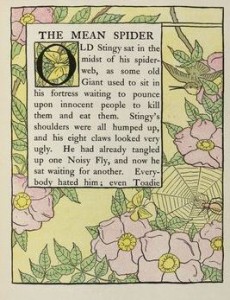Karen Raugust, Publisher’s Weekly, on some recent clarification (not exactly relief) for makers and sellers of new books under the Draconian law:
The Consumer Products Safety Commission recently issued a final lead rule that deemed many—but not all—of the components in ordinary children’s books safe. …
Most ink-on-paper and ink-on-board books will not have to undergo testing under various CPSC rulings. (Some so-called “ordinary” books, such as those with gold foil or spiral bindings, must be tested, and big retailers may require testing even when the CPSIA doesn’t.) All novelty and book-plus formats for children 12 and under must be tested by independent labs.
 However, the CPSC has yet to issue promised guidance to libraries on pre-1985 books:
However, the CPSC has yet to issue promised guidance to libraries on pre-1985 books:
Thom Barthelmess, president of the Association for Library Service to Children, a division of the American Library Association, says most librarians are waiting to see what happens. “We’re hoping for a happy resolution, so our collections aren’t decimated,” he says. If the CPSC’s ruling results in libraries needing to pull books from shelves, “there would be huge ramifications,” he continues. “If we lose a lot of titles printed before 1986, many of which are irreplaceable, it would have a huge impact on the nature of our collections.”
We’ve linked the coverage in Publisher’s Weekly several times over the course of the year but overlooked this report from March:
Most booksellers are now comfortable selling ordinary paper children’s books printed in 1986 and beyond. …
Half Price [Half Price Books, a large chain] removed all book-plus items from the shelves in every store and is warehousing them while it researches how to dispose of them in a safe and environmentally sound way, perhaps at a hazardous waste site.
And an official of the Independent Online Booksellers Association told PW in March that most members of the association were positioning their vintage children’s books as adult collectibles, which supposedly reduces legal risk, though as we noted in February, “the law provides that [retailers] are liable if they sell a product which will commonly be understood as destined for use by children, whether or not they label it as such.” Deputy Headmistress in February and Valerie Jacobsen in March also explained more about the practical drawbacks of the “relabel as collectibles” dodge, as has Elizabeth Mullaney Nicol more recently.
P.S. And welcome listeners at Hartford’s WTIC, where host Ray Dunaway had me as a guest on his show this morning to discuss the law. You’ll find much more here.
PUBLIC DOMAIN GRAPHIC: Edith Brown, illustrator, Jeannette Marks, The Cheerful Cricket and Others (1907), courtesy The Children’s Library.

4 Comments
Some of the favorite books in our school library (1-5) are pre 1986. They are regular books, however, not “book-plus” so maybe they are safe.
Funny that even Tenenbaum thinks books printed before 1985 are only used by adults. This from a previous educator. Guess she hasn’t visited a library recently.
Half Price [Half Price Books, a large chain] removed all book-plus items from the shelves in every store and is warehousing them while it researches how to dispose of them in a safe and environmentally sound way, perhaps at a hazardous waste site.
Maybe the EPA should send a hazardous waste disposal team in full protective gear to remove the books. After all we can’t be too careful when it comes to the children. Right? So how did my generation survive with all of these deadly books around?
Richard, I can only imagine it’s the lead in all the books our learned Congresscritters read when they were children that have tainted their MINDS and robbed them of all common sense when it comes to the CPSIA.